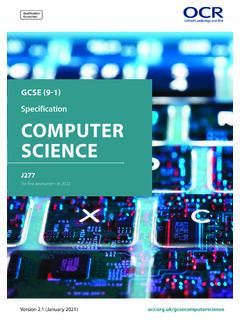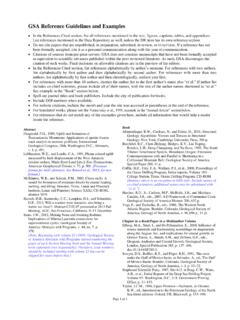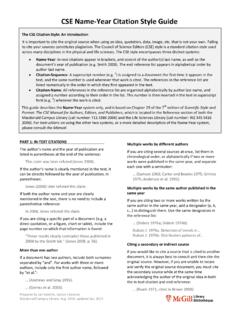Transcription of A GUIDE TO SDG INTERACTIONS: FROM SCIENCE TO …
1 A GUIDE TO SDG INTERACTIONS: FROM SCIENCE TO IMPLEMENTATIONA GUIDE TO SDG INTERACTIONS: FROM SCIENCE TO IMPLEMENTATIONA GUIDE TO SDG INTERACTIONS: FROM SCIENCETO IMPLEMENTATIONA FRAMEWORK FOR UNDERSTANDING SDG INTERACTIONS 0407 EXECUTIVE SUMMARY18 INTRODUCTION A FRAMEWORK FOR UNDERSTANDING SUSTAINABLE DEVELOPMENT GOAL INTERACTIONS M ns Nilsson (sei), David Griggs (Monash University), Martin Visbeck (geomar and cau), Claudia Ringler (ifpri), David McCollum (iiasa)31 SDG 2 END HUNGER, ACHIEVE FOOD SECURITY AND IMPROVED NUTRITION AND PROMOTE SUSTAINABLE AGRICULTURE Ludovic Mollier (ird), Fr d rique Seyler (ird), Jean-Luc Chotte (ird), Claudia Ringler (ifpri)34 INTRODUCTION35 KEY INTERACTIONS AT GOAL LEVEL43 KEY INTERACTIONS AT TARGET LEVELSDG 2 + SDG 1 SDG 2 + SDG 3 SDG 2 + SDG 5 SDG 2 + SDG 6 SDG 2 + SDG 7 SDG 2 + SDG 13 SDG 2 + SDG 1573 KNOWLEDGE GAPS 75 CONCLUDING COMMENTS81 SDG 3 ENSURE HEALTHY LIVES AND PROMOTE WELL-BEING FOR ALL AT ALL AGES Philippa Howden-Chapman (New Zealand Centre for Sustainable Cities), Jos Siri (unu-iigh), Elinor Chisholm (New Zealand Centre for Sustainable Cities), Ralph Chapman (New Zealand Centre for Sustainable Cities), Christopher Doll (unu-ias), Anthony Capon (University of Sydney)
2 84 INTRODUCTION85 KEY INTERACTIONS AT GOAL LEVEL91 KEY INTERACTIONS AT TARGET LEVELSDG 3 + SDG 2 SDG 3 + SDG 3 SDG 3 + SDG 8 SDG 3 + SDG 11 SDG 3 + SDG 13119 KNOWLEDGE GAPS 121 CONCLUDING COMMENTSA FRAMEWORK FOR UNDERSTANDING SDG INTERACTIONS 05127 SDG 7 ENSURE ACCESS TO AFFORDABLE, RELIABLE, SUSTAINABLE AND MODERN ENERGY FOR ALL David McCollum (iiasa), Luis Gomez Echeverri (iiasa), Keywan Riahi (iiasa), Simon Parkinson (iiasa)130 INTRODUCTION131 KEY INTERACTIONS AT GOAL LEVEL136 KEY INTERACTIONS AT TARGET LEVELSDG 7 + SDG 1 SDG 7 + SDG 2 SDG 7 + SDG 3 SDG 7 + SDG 6 SDG 7 + SDG 8 SDG 7 + SDG 13167 KNOWLEDGE GAPS 169 CONCLUDING COMMENTS174 SDG 14 CONSERVE AND SUSTAINABLY USE THE OCEANS, SEAS AND MARINE RESOURCES FOR SUSTAINABLE DEVELOPMENT Stefanie Schmidt (iass), Barbara Neumann (cau), Yvonne Waweru (iass), Carole Durussel (iass), Sebastian Unger (iass), Martin Visbeck (geomar and cau)
3 177 INTRODUCTION178 KEY INTERACTIONS AT GOAL LEVEL183 KEY INTERACTIONS AT TARGET LEVELSDG 14 + SDG 1 SDG 14 + SDG 2 SDG 14 + SDG 8 SDG 14 + SDG 11 SDG 14 + SDG 12 SDG 14 + SDG 13212 KNOWLEDGE GAPS 214 CONCLUDING COMMENTS215 LOOKING AHEAD NEXT STEPS226 ANNEX THREE ILLUSTRATIVE EXAMPLES OF INTERACTIONS BETWEEN SDG 2 AND THE OTHER SDGS237 IMPRINT Z E R O H U N G E RG O O D H E A LT HA N D W E L L - B E I N GL I F E B E L O WW AT E RQ U A L I T YE D U C AT I O NG E N D E RE Q U A L I T YC L E A N WAT E RA N D S A N I TAT I O ND E C E N T W O R KA N D E C O N O M I CG R O W T HPA R T N E R S H I PF O R T H E G O A L SP E A C E , J U S T I C EA N D S T R O N GI N S T I T U T I O N SL I F E O NL A N DC L I M AT EA C T I O NR E S P O N S I B L EC O N S U M P T I O NA N D P R O D U C T I O NS U S TA I N A B L E C I T I E SA N D C O M M U N I T I E SR E D U C E DI N E Q U A L I T I E SI N D U S T R Y, I N N O VAT I O NA N D I N F R A S T R U C T U R EN O P O V E R T YA F F O R D A B L E A N DC L E A N E N E R G YEXECUTIVE SUMMARYThe United Nations 2030 Agenda for Sustainable Development was adopted in September 2015.
4 It is underpinned by 17 Sustainable Development Goals (sdgs) and 169 targets. National policy - makers now face the challenge of implementing this indivisible agenda and achieving progress across the economic, social and environmental dimensions of sustainable development world - wide. As the process moves towards implementation, there is a need to address the scope and systemic nature of the 2030 Agenda and the urgency of the challenges. This requires a wide range of tools and SCIENCE -based analysis to navigate that complexity and to realise the report explores the nature of interlinkages between the sdgs. It is based on the premise that a SCIENCE -informed analysis of interactions across sdg domains which is currently lacking can support more coherent and effective decision- making, and better facilitate follow-up and monitoring of progress. Under standing possible trade-offs as well as synergistic relations between the different sdgs is crucial for achieving long-lasting sustainable development outcomes.
5 A key objective of the scoring approach described here is to stimulate more SCIENCE -policy dialogue on the importance of interactions, to provide a starting point for policy-makers and other stakeholders to set their priorities and implementation strategies, and to engage the policy community in further knowledge developments in this PRINCIPLESAll sdgs interact with one another by design they are an in te gra-ted set of global priorities and objectives that are funda men tally the range of positive and negative interactions among sdgs is key to unlocking their full potential at any scale, as well as to ensuring that progress made in some areas is not made at the expense of progress in others. The nature, strengths and potential impact of these interactions are largely context-specific and depend on the policy options and strategies chosen to pur- sue them. sdg 16 (good governance) and sdg 17 (means of implemen- tation) are key to turning the potential for synergies into reality, although they are not always specifically highlighted as such throughout the report.
6 For many if not all goals, having in place effective govern ance systems, institutions, partnerships, and intellectual and financial resources is key to an effective, efficient and coherent approach to SUMMARYP olicymakers, practitioners and scientists working at the global, regional, national and local levels on implementing or supporting the implementation of the sdgs are the intended au- dience for this report. KEY FINDINGSThe four sdgs analysed in detail in this report (sdg 2, sdg 3, sdg 7, sdg 14) are mostly synergistic with the other a 7-point scale, a team of scientists evaluated the key target-level interactions between an entry goal and all other goals, and attributed a score to these interactions based on their expert judgment and as justified through the scientific literature. The score most often allocated is +2 ( reinforcing ).The assessment identified 316 target-level interactions overall, of which 238 are positive, 66 are negative, and 12 are analysis found no fundamental incompati bilities between goals ( where one target as defined in the 2030 Agenda would make it impos sible to achieve another).
7 However, it did identify a set of potential constraints and conditionalities that require coordinated policy interventions to shelter the most vulnerable groups, promote equitable access to services and development opportunities, and manage competing demands over natural resources to support economic and social deve lopment within environmental process of systematically identifying and scoring inter-actions across the 17 sdgs using a common terminology is very valuable. It allows broad multi-disciplinary and multi-sectoral conversations, makes it possible to synthesise know ledge and to scope knowledge needs, and provides ra t-ional and concrete focal points (clusters of targets that need to be addressed together) for an integrated approach to implementation and monitoring. This approach provides a basis for a SCIENCE -policy dialogue on translating integrated SCIENCE for the achievement of the sdgs.
8 As a tool for policy coherence, it provides an understan-ding of the conflicts and synergies to be managed across government departments and sectors, understanding where the emphasis should be put for efficient and effective action, and identifies who needs to be brought to the table to achieve collective impacts across multiple interacting policy is clearly no one-size-fits-all approach to understanding target interactions, and building on this work will require a commitment to continuous iteration and SUMMARYSCIENCE-INFORMED ANALYSIS OF THE SUSTAINABLE DEVELOPMENT GOALS AND THEIR INTERACTIONSASSESSMENT FRAMEWORKThe framework on which this work is based identifies causal and functional relations underlying progress or achievement of the sustainable development goals and targets: positive interactions are assigned scores of +1 ( enabling ), +2 ( reinforcing ) or +3 ( indivisible ), while interactions characterised by trade-offs are scored with -1 ( constraining ), -2 ( counteracting ), or -3 ( cancelling ); neutral interactions between sdgs are assigned 0.
9 By systematically assessing the interactions and relationships between goals and targets, this report supports horizontal coherence across framework informs, but is not in itself a priority setting exercise nor is it a comprehensive mapping of all potential interactions. It can be applied at multiple scales (international, national, sub-national) through a thematic or geographic entry, and the analysis is based on existing literature and expert EXAMPLE: EFFECTS OF CLEAN ENERGY ON AIR QUALITY AND HEALTHS ustainable energy that is carbon-free is largely also pollution-free. This means that, in most cases, efforts to increase energy access (target ), expand the share of renewables in the energy mix (target ), and promote energy efficiency (target ) will lead to a simultaneous reduction in air pollutant emissions. As a conse- quence, interaction between the sdg 7 targets and target (reduc- ing air pollution) is considered reinforcing and so is allocated a score of +2.
10 Nevertheless, achieving sdg 7 may not in itself be enough to meet the air quality targets of sdg 3: additional pollution control technologies and measures may be APPLICATION Key interactions for Food / Agriculture (sdg 2), Health (sdg 3), Energy (sdg 7) and Oceans (sdg 14) are tested using the scoring frame-work. This selection represents a mixture of key goals aimed at human well-being, ecosystem services and natural resour ces it does not imply any prioritisation. This selection also covers a range of development and environmental priorities, including three goals under review at the 2017 High-Level Political Forum (sdg 2, sdg 3, sdg 14). Each of these goals exhibits both positive and negative target-level interactions with the other sdgs. In attempting to combine expert judgment, the seeking of new evidence in the scientific literature and extensive deliberations about the character of different interactions, it soon became clear that despite starting from similar understanding about interactions and the main conceptual underpinnings of the framework, the different 10 EXECUTIVE SUMMARY teams quickly developed different interpretations of how to apply the framework and score the interactions.





